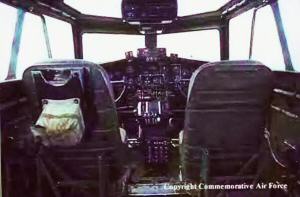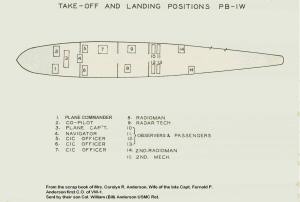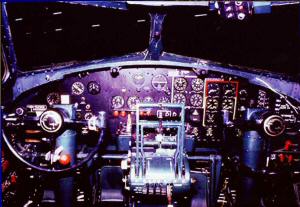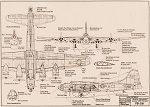The PB-1W aircraft began their military career as B-17G-95-DL's. They were manufactured by Douglas Aircraft Corporation at Long Beach, California, (under license from Boeing Aircraft. Corporation, Seattle, Washington) and were delivered to the U.S. Army Air Corps in 1945. The aircraft were then transferred to the U.S. Navy and delivered to the Naval Aircraft Modification Unit (NAMU) at Johnsville, Pennsylvania.
Following Navy acceptance, the aircraft were designated as PB-1 and assigned Navy Bureau Numbers. They were then placed in storage to await modification. In late 1946 the aircraft were modified to the PB-1W configuration. Modifications included the removal of all armament, the armor plate was removed at a later date to save weight, by 1950 all had been removed; installation of the General Electric AN/APS-20 radar with its antenna mounted under the fuselage in a large bulbous fiberglass dome over the sealed bomb bay doors; advanced IFF; relay-radar transmitter; and advanced radio equipment so the aircraft could communicate with both ship borne CIC's and other aircraft. In addition to the radar and electronic equipment, these aircraft had four (4) additional 270 gallon fuel tanks, two in each outer wing section.
| Aircraft Specifications | |
|---|---|
| Wing Span | 103 ft. 9 in. |
| Length | 74 ft. 9 in. |
| Tail Plane Span | 43 ft. |
| Height (top of rudder) | 19 ft. 1 in. |
| Engines (4) | Wright "Cyclone" R1820-97, 9 cyl. Radial, Turbo-supercharged |
| Horse Power on Take-off | l,200 ea. |
| Fuel Capacity (115/145) | Internal: 2,780 Gal. (4 - 425-gal wing tanks 4 - 270 Gal. outer wing tanks) |
| Auxiliary Fuel | External, removable: 2-310 Gal. tanks when needed |
| Weight (empty) | 34,000 Lbs. |
| Weight (max take-off) | 65,000 Lbs. |
| Radar | AN/APS-20/A |
| Speed (Max) | 250 kts |
| Speed (Cruise) | 140 kts. AEW Operations |
| Stall Speed (normal landing) | 83 kts. |
| Service Ceiling | 35,000 ft. |
| Endurance | 16 hours (without auxiliary tanks). |
|
Crew Operational Missions |
11 (6 Officers 5 Enlisted) Officers: Plane Commander, Co-Pilot, Navigator, CIC Officer, 2 Radar Operators/Controllers Enlisted: Plane Captain (AD), 2nd Mech. (AD), 2 Radiomen (AL), Electronic Technician (AT). |
|
Crew Minimum |
5 (2 Officers 3 Enlisted) Officers: Plane Commander, Co-Pilot, Enlisted: Plane Captain (AD), 2nd Mech. (AD), 1 Radiomen (AL). |
| Crew Comfort | Electric stove for hot meals coffee |
pb-1w interior
Forward Compartment:
Basically the B-17G configuration. The bomb sight was removed except for the Auto-Pilot unit. The Bombardier's station was maintained and used for a lookout on Anti-Submarine or Air-Sea Rescue missions. The Chin Turret was removed. The turret outer fairing was removed while on some aircraft. the outer fairing was maintained.
The Navigators station:
Identical to B17G.
Flight Deck:
 Thanks to Ken English of the "Commemorative Air Force" for use
of this picture. This aircraft. was once a VW-1 PB-1W BuNo 77235 with side and tail code TE-12. This aircraft
is still flying with the "Gulf Coast Wing" of the "Commemorative Air Force" out of Houston TX. as the Texas
Raiders, N7227C.
Thanks to Ken English of the "Commemorative Air Force" for use
of this picture. This aircraft. was once a VW-1 PB-1W BuNo 77235 with side and tail code TE-12. This aircraft
is still flying with the "Gulf Coast Wing" of the "Commemorative Air Force" out of Houston TX. as the Texas
Raiders, N7227C.
The flight deck was the B-17G configuration with updated radio and IFF equipment. The instrument panel was modified by the addition of flight instruments to the Co-pilots side. The upper turret was removed but some aircraft. still maintained the external turret ring.
Bomb Bay Area:
A floor was installed in the bomb bay at a slightly lower level than the Walkway. Two Radar Consoles were installed on either side of the walkway at the front of the bomb bay with the operators facing to the rear, their backs against the Flight Deck bulkhead. The CIC Officer's position was at the right rear of the bomb bay. The left. rear of the bomb bay contained the electronic and radio equipment. Curtains were installed at either end across the doorways to darken the area. The bomb bay doors could be manually opened to service the antenna and rotating equipment after the lowering of the radar dome.
Radio Compartment:
Similar to a B-17G except the radio operator's desk along the left. side was larger and the operator faced outboard. Up-dated radio equipment was also installed. A Radar Technician position was added on the starboard side, slightly aft. of the Radioman, with the Technician facing outboard in front of a Radar Control Panel.
After Station:
The waist guns and ball turret were removed. Benches were installed under each waist window for lookouts. A two burner electric range was installed on the right side just aft. of the waist window with storage under the unit. There was a gasoline powered Auxiliary Power Unit (APU) mounted just forward of the tail wheel well. This unit was operated during start up to provide electrical power to start and on takeoff and landing to provide emergency power if needed. Six floating 'smoke bombs' were carried to be dropped during Anti-Submarine operations to mark a submarine's location or on Air-Sea Rescue missions to mark and assist in locating survivors.
Tail Compartment:
Same as a B-17G except the guns and armor were removed. This area was often used during deployments to carry spare parts.
Additional Information and comments from George Stewart:
 This picture (click on picture to enlarge) shows the positions of the various PB-1W crewmembers during
take-off and landings. With the exception of the Navigator and the Observers, these positions were also the
positions used during an operational mission.
This picture (click on picture to enlarge) shows the positions of the various PB-1W crewmembers during
take-off and landings. With the exception of the Navigator and the Observers, these positions were also the
positions used during an operational mission.
The Navigator and forward Observer would gain access to their stations via an opening between the Plane Commanders's (PC's) seat and the Co-pilot's seat which went down into a tunnel. then forward through the tunnel to the nose compartment. The Navigators station in the nose compartment (Lower Deck) was about 8-10 feet in front of the PC. When the navigator was taking a star-shot you could see his head in the Plexiglas dome just in front of the cockpit.
In the event of a water landing a PB-1W was dangerous, the only way out was through the PC's side window and the Co-pilots side window, the upper Plexiglas section, if you could get it open, above the rear of the radio compartment or breaking out the two waist windows. The life rafts were stored in compartments in the top of the fuselage, on either side about mid wing. Once outside you had to walk on top of the fuselage to get to the life raft. compartments or swim to the wings and climb up.
In a PB-1W it was possible to crawl on either side of the tail wheel back into the tail gunner's station. It wasn't easy as the space was tight. Some passengers/observers often went back there to see what it was like. I remember going back there when I first started flying, but the feeling was of being confined with nothing to see except sky. It was quiet and you felt all alone. I never went back there again. G.E.S.
The PB-1W was noisy and either cold or hot, none of which you could control. For heat there were heat exchangers in the exhaust pipes of the 2 & 3 engines which did not put out much heat. To cool the after station we would point the gun mounts in the waist window forward as air scoops. In general there were enough openings in the aircraft. to allow air in. There was only the aluminum skin between you and the outside. No sound proofing or insulation. You wore summer flight suites or long johns, sweaters and flight jackets as needed.
Attached is a Blueprint for the PB-1W from an old B-17G blue print.
Thanks to Chris Seal ATR-2 VW-1 66-68 for this work


